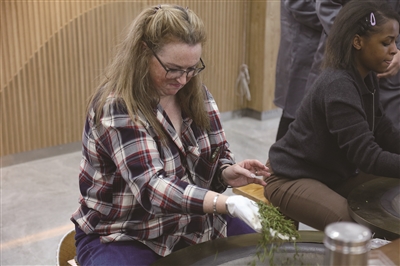
Hazel was experiencing tea frying in Longwu Tea Village. Photo provided to Hangzhoufeel
Experiencer
By Hazel Fiona Self
Whilst waiting for the kettle to boil, have you ever wondered how tea is made? I don't mean simply pouring water over loose leaves in a pot. I mean, How tea is ACTUALLY made from fresh leaves?
Last weekend, thanks to Hangzhoufeel, I got to find it out at the 2023 Hangzhou Tea Culture Exhibition in Longwu Tea Village.
Upon arrival, we were taken to watch the Longjing Tea Stir Frying final, where rows of competitors sifted, sorted and fried leaves in a bid to win the coveted title of top Longjing Tea Stir Frying Master. The fried leaves are judged on appearance, aroma, tea soup color and dregs.
Then, after a wander around the many stalls selling everything from tea sets to crocheted dolls and a quick stop to watch a digital performer, it was over to Etuton Global Tea for a factory tour, where we learned about the growing, picking, sorting, drying and frying processes of the Longjing Green Tea that so many of us enjoy.
Every cup of this world-famous tea starts with leaves which are only found on plantations around the West Lake here in Hangzhou. In early spring, prior to the Qingming Festival, experienced pickers select only the bud and two leaves from the tips of the tea bush, carefully nip them and leave them on bamboo sieves to air dry. Once the moisture content is reduced to around 10-13%, they're ready for the next process, shaqing, or literally "kill the green". This Intangible Cultural Heritage of Humanity known as the West Lake Longjing Tea Making Technique is where the air-dried leaves are fried in cauldrons which are heated to over 280 degrees until the plump, bright green leaves change to the dried, khaki leaves we recognize.
Unexpectedly, we were encouraged to take a seat and experience tea frying for ourselves. Under the expert guidance of a resident tea master, we initially sorted leaves in a bamboo basket, removing any deemed too big, too old or too damaged. Once we were left with only the best quality leaves, we oiled the preheated cauldron and poured them in. We constantly moved the leaves, rhythmically pushing them away, pulling them towards us, lifting them and shaking them gently through the open fingers of our hands, always careful not to make skin contact with the searing heat of the pan. The earthy, woody aromas drifted up as the leaves changed color and texture. All too soon the relaxing, almost therapeutic process was over and after letting the "masterpieces" cool, the leaves were transferred to souvenir tins for us to take home and impress our families.
So, next time when you boil the kettle to make a cup of tea, just think about all the work that goes into making that mellow, fresh flavored Longjing tea.
